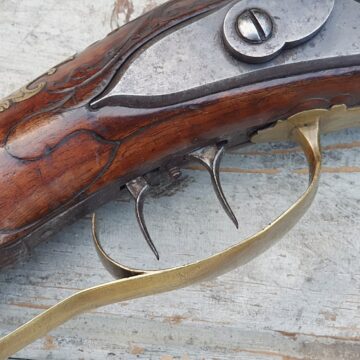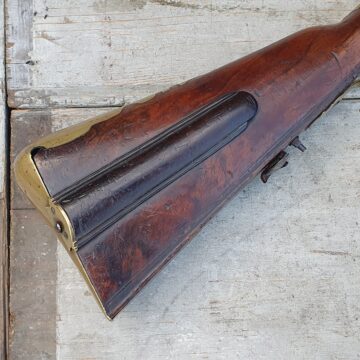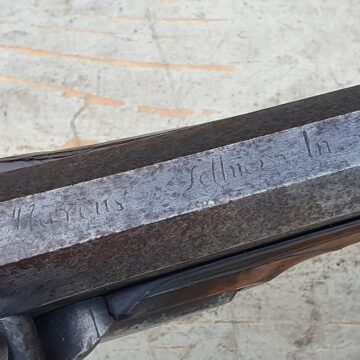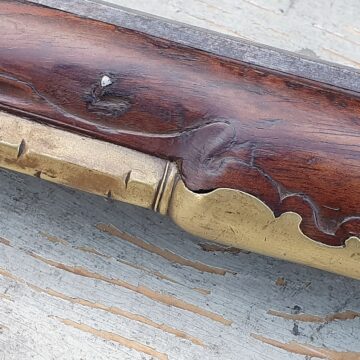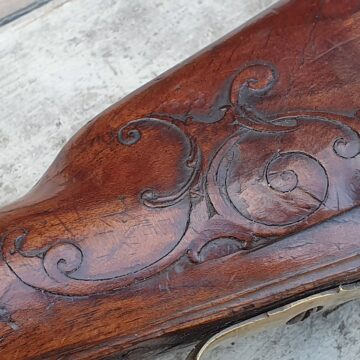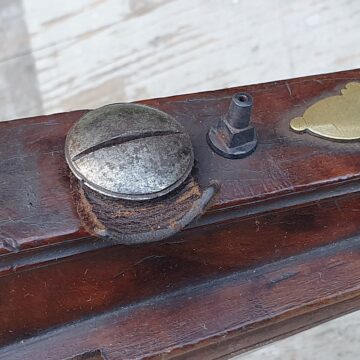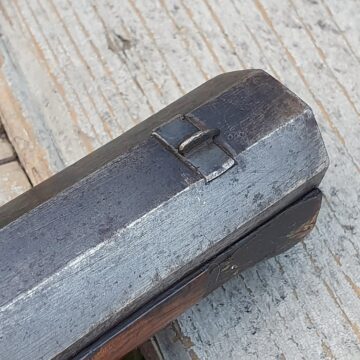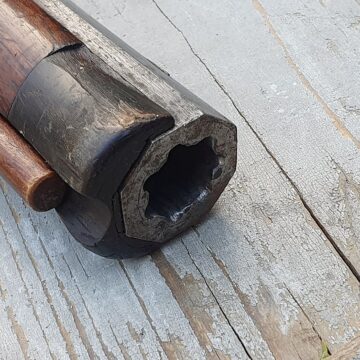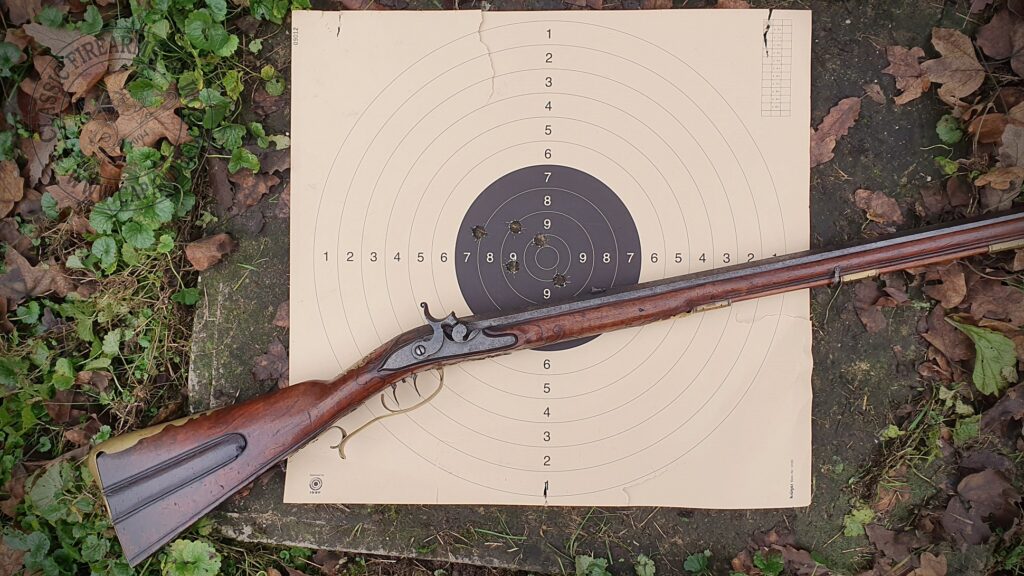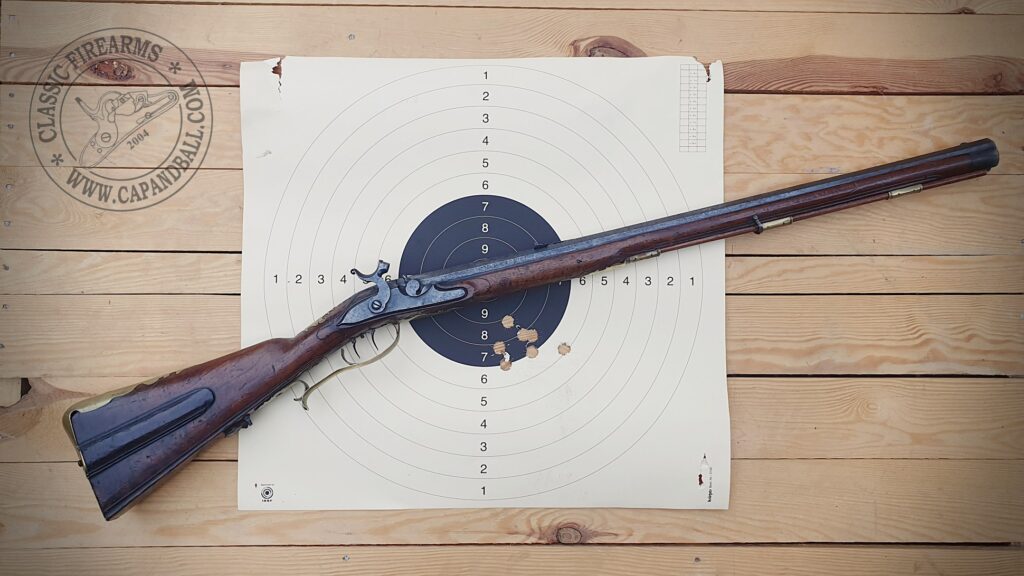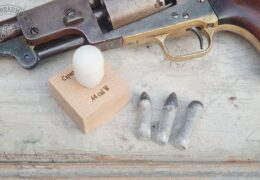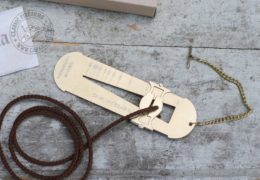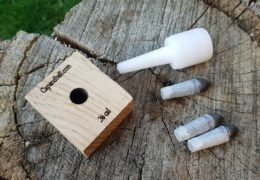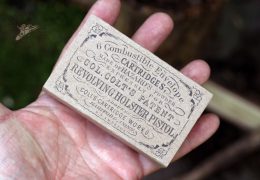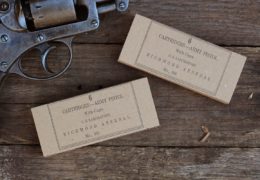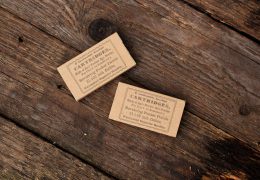The Germanic Jager rifle – article and film – Part 1.
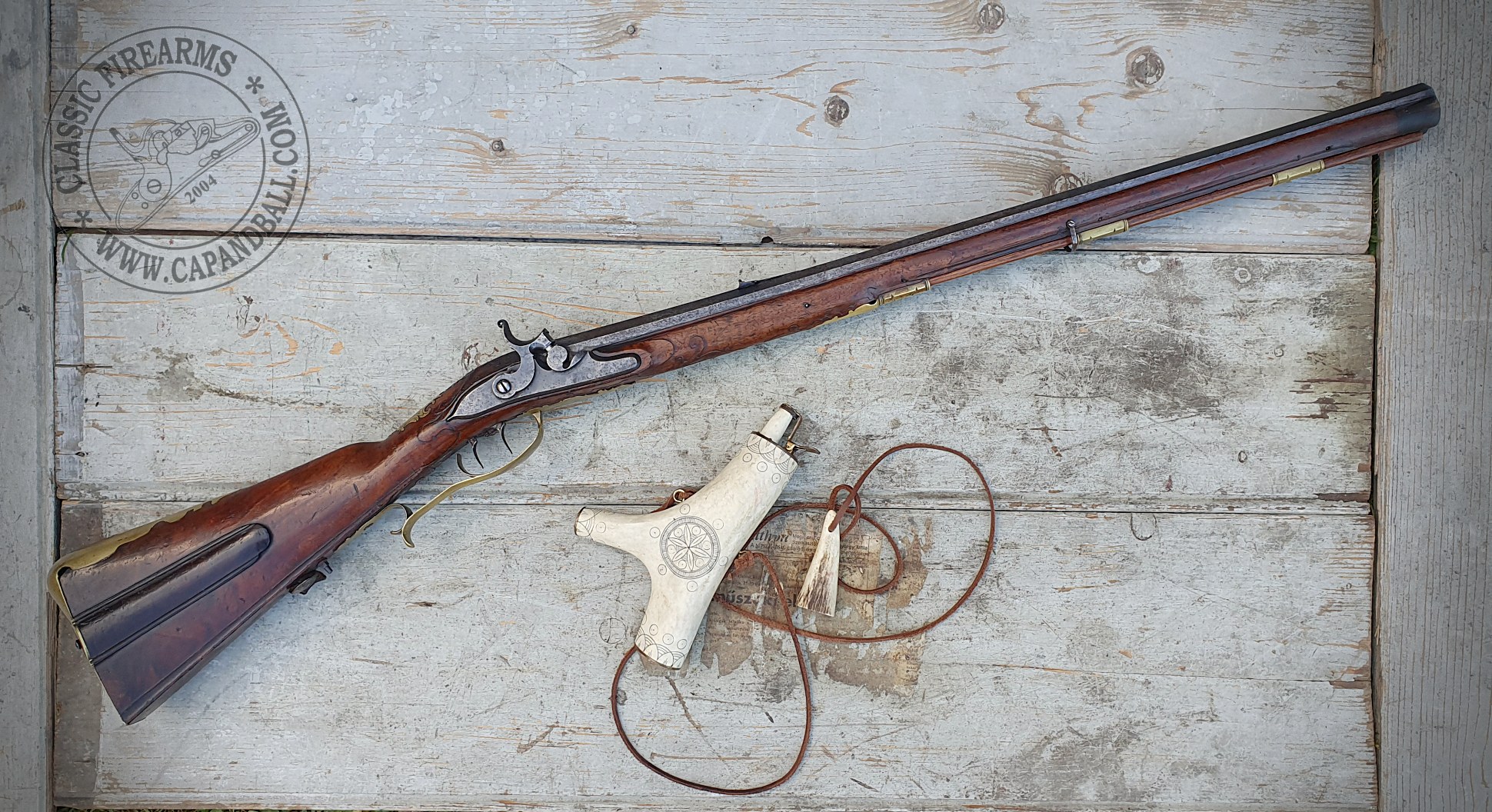
The type of robust rifle we call today as the Germanic Jäger or hunting rifle was born in the beginning of the 18th century with the spread of the flintlock ignition system. It evolved from the short wheel lock hunting rifles. Let’s check what were the main characteristics:
The bore is of carbine length, shorter than the contemporary muskets, but longer than the classic 16th-17th century wheel lock hunting carbine or Stutz. The caliber is seldom smaller than 13 mm, but the most common bores are between 14-16 mm. The bore is heavy with usually dovetailed rear and front sights. The twist of the rifling is usually fast, faster than what we use for batched round balls, usually between 1 turn in 30 to 40 inches. The number of grooves is usually 6-12, the grooves are always very deep, the odd numbers are more common than the even numbers. The stock is heavy, usually made of walnut or fruit tree woods. The wood is robust, the barrel is held by pins or wedges. The stocks usually have a sliding patch-box, never hinged as seen on Kentucky and Pennsylvania rifles. The trigger can be singe direct trigger or a double set trigger system. Singe set triggers are seldom find, nearly never.
These rifles were never fragile, they were built to last, so when the percussion ignition was invented, most of these rifles were converted by drilling out the touch hole and screwing a drum and nipple into the breech. The flintlock was easy to convert with removing the pan and frizzen, and replacing the hammer.
The invention of the percussion ignition is credited today to John Alexander Forsyth, a Scottish presbyterian clergyman, but we know that the fulminates of mercury were invented before him. He patented his scent bottle lock in 1807. The invention aroused the interest of Bonaparte Napoleon himself, and offered a large amount of money to sell his invention to France. Forsyth refused the offer. The percussion cap however was a parallel invention in the second decade of the 19th century. Excellent gunsmiths like Joseph Manton, Francois Prelat, Joseph Egg or Peter Hawker.
The US history of the cap is related to Joshua Shaw, who patented his copper percussion cap on 19 June 1822 and offered his invention to the Government. The Government immediately started using the invention, but never bought the patent. Shaw had to wait until 1844 when the Secretary of War authorized a payment of $18,000 finally to the inventor.
This type of Jager rifles were the predecessors of many civilian and military arms. These rifles were carried to the new world, and the Kentucky and Pennsylvania rifles are considered the longer, smaller calibre versions of old Jäger rifles. These excellent arms found their way to the battlefields of Europe as well. From the middle of the 18th century it was the principal arm of the regular light infantry. Such excellent arms derived from the Jäger rifle as the Baker rifle of the British Army.
The Zellner rifle
The Zellner family was a very well know firearms maker in Austria from the 17th century. They operated in Wien, Salzburg and Zell am Wallersee. Marcus, son of Balthazar Zellner was born in 1693 in Zell am Wallersee, in the small village close to the border of Bayern and Austria. He completed his apprenticeship at his fathers’s gunsmith shop, and started his mandatory journey to learn more about gunsmithing. He returned to Wien in 1726 and became a master, and the same year he married Anna Katharine, daughter of Felix Meier gunsmith. He died in 1758 at the age of 65. The rifle was made in Wien, so we can be sure that it was made sometime between 1726 and 1758. It was converted to percussion – in a very elegant way – sometime in the first half of the 19th century.
The weight of the rifle is 3.3 kg. The calibre of the bore is 16mm. The length of the barrel is 695 mm. The bore is rifled with 7 right hand grooves, with 1 turn in cca 30 inches. There are quite a few markings on the bore. Behind the rear sight the name of the maker is visible: “Marcus Zellner in Wienn”. On the top of the tang No. 2 is visible, so I suppose this rifle had a twin, the number one. It surely was a beautiful brace.
The family Esterházy
The Esterházy family is one of the most known noble families of Hungary. They gave more palatines to the Kingdom. The palatine was the second after the King. The family was erected to the rank of duke in 1687, after Pál, the first prince saved the Holy Hungarian Crown from the advancing Turks, and took part in the battle for Wien on the side of the Emperor. The family donated many important politicians and artists to Hungarian history, both from the princely and count branches of their family tree. The most known side of the family lived in western Hungary, with beautiful castles in Kismarton (now in Austria, called Eisenstadt), Fertőd, Fraknó (now also in Austria called burg Forchtenstein, with a beautiful firearms collection).
Why the rifle can be associated to the family? Because the coat-of-arms of the princely branch is still visible on the small brass shield inleted into the top of the wrist.
The connection of the family to hunting
Probably the highlight of the hunting history of the family is associated to the end of the 18th beginning of the 19th century, exactly to the time when this rifle must have been in use. Paul Anton Esterházy the III was an extravagant host. We welcomed large number of noble hunters on his famous hunting ground in southern Hungary, close to Tamási, near Ozora.
This area still has one of the best fallow deer and red deer populations in Europe. These hunts were mainly driven hunts, kind of hunts that today we no more consider ethic hunting. The game was driven by dogs and the beaters. The prince had more than 2000 dogs at a time. The hunters, or let’s just say shooters were placed in pavilions, and they shot the game as in a shooting gallery. Not really noble by today’s standards, but these hunts played an important role in the civilian reform period of the country.
The preparation for these hunts started 2-3 days before the event. The beaters quietly, gently drove the game towards the centre of the selected close gardens from the four sides of the land to compress them in the central area of the ground. To ensure that they will not return in the night, they lit large fires around the centre zone for the night. This part was also surrounded by a net, so the frightened game shall not exit the prison.
The pavilions were placed at the edge of the net. Each pavilion accepted two hunter, six loaders and two loading stands for 12 rifles. The game did not have a chance at all. The frightened deers, boars ran in circles around the net trying to find the way to escape, but there was no escape. All were killed. There were hunts that resulted over 1000 trophy games in one day.
Today we consider this method of hunt brutal and unethical as it does not fulfil the most important aspect of hunting: giving chance to the game.
This was of course not the only method of hunting. The nobles were also able to stalk on open grounds, following the same ethics as what we share today.
Prince Paul Anton Esterházy III. spent the last years of his in comparative poverty, isolated from the high society. Hi extravagant life was just too much against the income of his properties. Hi estates were placed in the hands of curators.
Proofing the gun
So this rifle was owned by the Esterházy family, and it’s large calibre was very suitable for this kind of short range hunting. It is a good question why we want to hunt or shoot with an antique rifle like this. And before we go on, I really have to say that repros are much better choice for everyday sporting. But let’s not forget that shooting sports have their role in preserving these arms. Those arms survive centuries which were used, and not just hanging on a wall to be eaten by rust. So, if we decide to hunt with a gun with historical value, we must be very careful. We must never do anything that can reduce the historical value of these artifacts.
Let’s follow me now to the CIP proof house of Hungary to show you the process each black powder arm has to pass before we take it to shooting or hunting. Our guide is Mr. Emil Hamza, secretary of the CIP delegation of Hungary.
The inspection has three stages: pre proofing, proofing and after proofing. The process starts with the visual inspection weather the arm has all the necessary markings, like the name of the maker, country of origin, calibre, serial number and maximum allowed load. The next is to check if all parts are absent of damages that can effect the safety of the gun. The gun is disassembled. The first is the inspection of the barrel, that is done with a borescope searching for bulges, cracks, and corrosion in the barrel and at the breech are as well. The drum and the nipple are also closely examined, especially the threads so the rifle won’t spit the nipple into the head of the user.
Just a note: if you are searching for an antique arm for shooting or hunting, avoid the Damascus barrels, as in many cases is not possible to detect the corrosion between the twists. It is better to use monolith barrels.
The next part is the lock. If it has a safety notch it has to hold the hammer firmly, and also the full cock position has to be safe from unintentional discharge. The trigger system is examined the same way also. Then comes the stock. It is checked for cracks and holes from woodworms that can render the use of the arm dangerous.
If there are any abnormalities that reduces safety or that ensures that the proofing will damage the gun, the gun is rejected. If everything seems to be good, the rifle proceeds to the proof test. The barrel is separated from the stock so the wood will not be stressed by the increased recoil of the proof charge. The proofing charge is dependent on the calibre and type of the gun, but always means higher propellant and projectile weight, and of course much higher gas pressure than the standard service load of the rifle. Proofing is done using Swiss black powder as this product delivers the highest pressure and energy among all the commercially available black powders.
After the proof tests the gun is examined again to record if there were any changes in the status after the high-pressure charge. If no changes were recorded the gun will receive the necessary black powder proof marks. To save the historical value, these marks are placed carefully, not to damage the visual and physical value of the gun.
The charge of the rifle
Even if the rifling is in excellent condition, we can be sure that much work will be needed to set the right charge for the rifle. Based on my experience this takes at least 1-2 months range time, depending on how often you can work on the load.
The round ball has a diameter of 15.9 mm, with a patch of 0.5 mm thickness. This is a tight combo, but possible to load even with the wooden ramrod of the rifle, which is necessary for hunting purposes. The grooves are very deep, that’s we need pillow thick patching to have a gas tight seal. This was the first time I was using patch milk for lubrication. An old friend of mine, who is actually a colleague as well in the Capandball firearms store makes this staff. He is a chemist, so he knows what he is doing. I have been using his revolver grease for many years now, and now I tried his patch milk as well. I have to say that I love it. I always used spit patches, but this stuff is much better. The fouling buildup is minimal, and it was very-very easy to clean the bore.
I had to play a lot with the black powder charge of the rifle as the deep rifling needs some extra care. These rifles were manufactured with much faster twist rates than the ones we use today for roundballs, meaning we will not be able to overcharge the rifle, as the group will open up. My job here will be to find the maximum load that delivers a tight group in the open sight hunting distance. The rifling in the breech is not perfect so I started with 75 grains of 1,5Fg Swiss powder with 40 grains of semolina to increase the volume of the charge. The patch is pillow thick, as the grooves are really deep. Although the twist of the rifling is fast, it is clearly designed for patched round ball as the edges of the lands are rounded so, they won’t cut the patch.
Measuring the twist rate of the bore is not a complex job. First put a jag matching your bore on your ramrod, and use tight patching. Push the ramrod down the bore and mark it with a piece of tape to act like a clock hand. Remember the direction of the hand and start pulling the ramrod gently while it turns with the rifling. Stop at half turn and measure the distance of the tape to the muzzle. Multiply this by two and you have the twist rate of your bore. My bore measures around one complete turn in 31”, that is fast for patch round ball, but this was quite common for these old Jäger rifles.
The first 50-meter groups were satisfying. Not hole in hole accuracy, but enough for hunting. I was still using the original nipple with the original cone shaped large touch hole that is large at the bottom and small at the end where we put the cap. Today’s nipples are the opposite, the narrowest part of the touch hole is in the bottom to increase the velocity and pressure of the gases of the priming compound. These nipples usually deliver better groups than the old one. So, I turned a new nipple with 0.8 mm touch hole and tried it.
The result at 45 meters was really satisfying, so I moved on to 80 meters, the outer edge of the open sight hunting distance.
So finally, I arrived to load that is suitable for hunting. There is one more option I have to improve the group, but I think I am not willing to make this modification. The muzzle crown of the rifle is damaged, that could be repaired, but I don’t think it worth it. This rifle will not be an everyday hunting rifle, I will still use my Pedersoli Jäger rifle for rough hunting times, so I will just leave it as it is today.
Balázs Németh, December, 2020.


